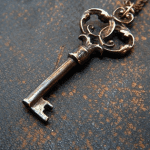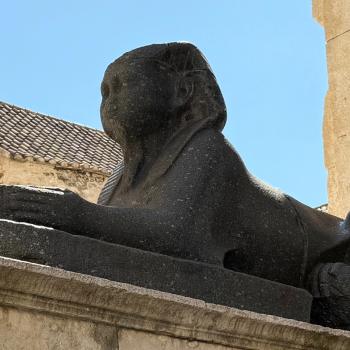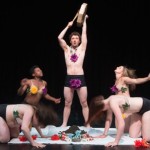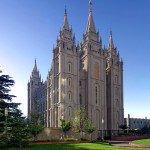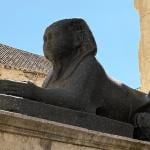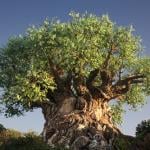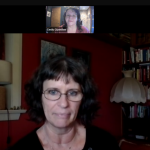Last night during our (belated) family Autumn Equinox ritual, my wife got frustrated. Specifically, she got frustrated because of the “fuzzy” nature of Neopagan myth.
Here’s some background: My wife’s LDS (Mormon), but very supportive of my Pagan faith. In case you’re just joining my blog, I used to be LDS. I left the Mormon church formally about 3 years after we were married. I spent about the next couple years in limbo, until I started identifying as Neopagan. And then it was still many years until I figured out what that meant and began including my wife and children in my Neopagan practice. My wife, I think, had a harder time with my limbo years than with my Paganism — she was just happy that I had found something and that I was willing to include her and the kids.
To give you an example, when it came time for my daughter to be baptized in the Mormon church (8 years old), my wife agreed we could also do a “Pagan baptism” too. Of course, Pagans don’t usual do baptismal rituals, and they tend to eschew anything resembling Christianity. But I ritual immersion is a beautiful symbolic tool that Pagans can reclaim, so I came up with the idea of a Pagan baptism in which the water represented the womb of the goddess, and the immersion represented, not washing away sins, but experiencing a connection to the source of all life.
Of course, a Pagan baptism had to take place in a natural body of water, not in some baptismal font like Christians often use. So we all went to at the dunes at Lake Michigan with my wife’s (Mormon) parents and my (agnostic/atheist) family. And we all wore T-shirts that said “Jesus Loves the Little Pagans”. We sang Peter Mayer’s “Blue Boat Home”. And when my wife and I stood the water with my daughter, we we said the following “prayer”, which I wrote, combining a little Goethe and a little Tielhard de Chardin:
She is the womb and the tomb:
An eternal ocean; changing, glowing, roaring, life in ferment.
Like the swirling of life, she rises and falls:
From her all things come, and to her all things must return.
Son/Daughter of earth, plunge yourself into the sea of matter,
Which is her body, for it cradled you long ago.
And then my daughter said:
She has been with me from the beginning, and she will be with me until the end.
My son decided he wanted to have a Pagan baptism too, even though he had been baptized in the LDS Church three years earlier, so we did the ritual for him too. It was a perfect day. And my wife really got into it. I share this story so you can appreciate how flexible my wife has been. But I guess it also shows how flexible I have been with Pagan (and Christian) ritual forms.
But last night my wife got frustrated. I was explaining (mostly to the kids) about the meaning of the equinox, and trying to put it in the context of the whole Wheel of the Year, and my wife felt confused. Part of the confusion stemmed from the fact that there are so many versions of the Wheel of the Year. I came across a website (now no longer accessible) years ago which set out five basic versions of the Wheel. Fortunately I saved the information and was able to re-post it at AmericanNeopaganism.com.
One of the principal differences in these versions is that, in one version of the Wheel of the Year, the Oak King/god of light is sacrificed at the summer solstice, and in another, he is sacrificed at the equinox. I prefer the latter version (Mike Nichols wrote a great article about this entitled “The Death of Llew”), but it’s not like I get upset if I attend a public ritual that uses the other version. It can work either way. Last night, I even had us listen to Damh the Bard’s “Noon of the Solstice”, even though it was the equinox, because the song is about the battle between the Oak King and Holly King. But this just created more confusion for my wife, who was still trying to keep straight who Isis and Osiris and Persephone and Hades were. It was not until then that I realized how strange Neopagan myth must seem to someone who belongs to a religion which has an actual “doctrine” or dogma.
Now my wife is hardly dogmatic. Of the two of us, I was definitely the one of the black-or-white mentality, at least I was back when I was Mormon. But stories play a very different role in our respective religions. In Mormonism, like most other Christian religions, the validity of the religion is premised on the accuracy of certain historical claims. In Mormonism, in addition to the basic Christian story, there is the story of the “Restoration”, the foundation myth for the Mormon church, which begins with Joseph Smith in 1820.
Neo paganismhas a very different relationship to stories. To borrow asaying from the Roman philosopher Sallustius, these stories never happened, but they are happening all the time. In short, they are myth.
One of the the things that drew me to Neopaganism was the belief that the Neopagan community had moved beyond its need for historical authenticity. This was due largely to the fact that the first book on Neopaganism that I read was Ronald Hutton’s Triumph of the Moon. Thus, I came into Paganism with the belief that the community had come to terms with its religious history, i.e., that Gerald Gardner created Wicca from the sources available to him, that there was no widespread matriarchal culture, and that contemporary Neopaganism has very little in common with ancient paganisms.
As I became more involved with the Pagan community, I was surprised to learn that the situation is a little more complicated that I had thought: There are Heathens and Reconstructionists who do strive for historical authenticity. And there are some who still believe in the survival of a witchcraft tradition from early modern times. And there are those who still idealize the Pagan past.
I had a different idea of authenticity though. In Sign of the Witch, David Waldon states that the focus of American Neopaganism is not on historical authenticity to an ideal pagan past, but on creating what Waldron calls a “Pagan consciousness”, which I would describe as an experience of connectedness — of our souls to our bodies, of our bodies to this earth, of the earth to the cosmos, and of each of us to one another — and of the reciprocal relationship between life and death. The stories I choose to tell are intended to cultivate this “Pagan consciousness”.
Thus, in yesterday’s ritual, I took quite a deal of poetic license with the story of Isis and Osiris. I simplified the story for the sake of my audience, which included children, but also for the sake of conveying my message more clearly. There is a long history of such “poetic license” in Neopaganism going all the way back to the grandfathers of Neopaganism, Robert Graves and James Frazer, and from them back to ancient myth. Anyone who has studied Greek myth in any detail quickly learns that there was no single, monolithic narrative. The poets contradicted each other more often than not. No single narrative was considered sacrosanct, not even Homer’s.
All of this an be disconcerting when coming from a religion that claims to have exclusive possession of the capital-“T” Truth, and which bases that claim on stories which are believed to be the revealed “Word of God”. I guess the lesson for me is to remind my wife and kids before any ritual, that the stories that I am telling are not meant to be historical claims. They are meant to be metaphors. They are meant to evoke a mood. And most of all, they are meant to transform us.



